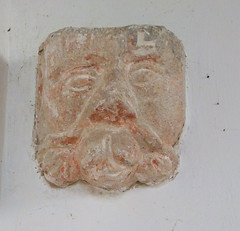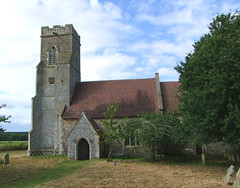| |
|
St
Andrew, Illington
 |
|
The
Breckland is the strangest part of East Anglia,
tiny sparsely populated parishes scattered with
heaths and pinewoods alternating with vast
acreages given over to military exercises and
industrialised agriculture. It was one of the
most populous parts of England in the early
medieval period, and consequently has more
disused and ruined medieval churches than just
about anywhere else in the country. St Andrew
was, at one time, disused. But it escaped
ruination, and today is looked after by the
Norfolk Churches Trust as well as a small but
determined group of locals. The church
is about half a mile from the nearest road, set
on the edge of Park Farm. You reach it by a muddy
track that goes around the north side of the
farmyard, although you can walk along the
bridleway which runs along the edge of the field
if you are on foot. Or horse, I suppose.
The
churchyard is large and rectangular, with a few
dozen headstones, mostly of the Victorian period.
In the mid-19th Century, when rural East Anglian
populations reached their peak, Illington parish
had fewer than a hundred residents, mostly living
and working on the Illington Hall estate, which
belonged to the Churchman Long family, who also
conveniently provided the Rectors for the church.
|
On this
late summer afternoon, the churchyard was a silent place
apart from the birdsong and the wind in the trees. It
felt magical. The grass had recently been cut, which made
the north side of the church seem barren, but the south
side has gnarled trees that stoop and seem to shelter the
Illington dead.
| A
late medieval tower, a church against it which is
essentially Norman. There was a restoration in
the 1840s, which gave the furnishings, and then
another in the 1890s which undid some of the work
of the earlier restoration, revealing the Norman
lancets again. At some point the south aisle was
demolished, and the arcade filled in with curious
neo-Early English windows, presumably at the time
of the earlier restoration. The font is rugged, a
bit lumpy on its wide base. The faded 19th
Century stencils on it are haunting. Twenty years
ago this place was derelict, but it has been
gradually nurtured back to a proper state by the
Trust, who made the tower safe and rebuilt the
floor inside. This is a simple place, quiet and
fitting for Anglican worship. The blocked
north doorway contains a marble cross to
Lieutenant William Anthony Harvey of the Norfolk
Regiment and the Royal Flying Corps. He was
captured by the Germans and, after being
transferred to an internment camp in Switzerland,
died there on 7th November 1917. He was 26 years
old. At the time of the 1911 census, the Harveys
were living at the Hall, and William was the sole
heir to the estates. Now he was dead, and the
Hall was demolished soon afterwards.
|
|
 |
|
|
|



